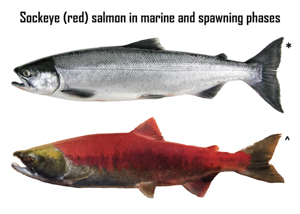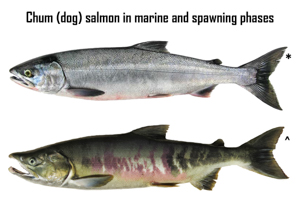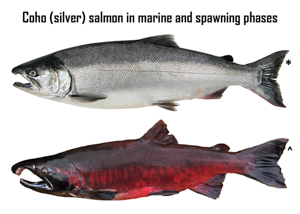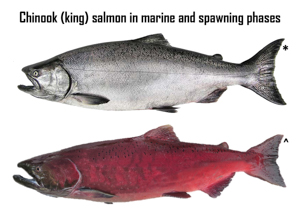
Reel Times Newsletter
May 2021
Issue 41
Take Five - Are you up for the challenge?
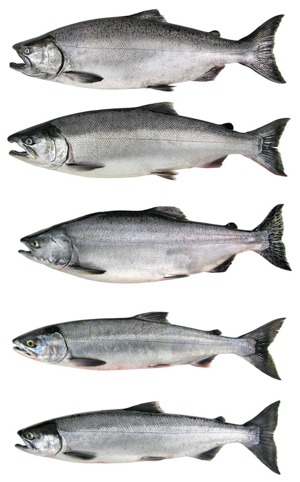 May is that pivotal month when many Alaskan anglers turn their attention to targeting salmon. And rightfully so. Salmon are an exciting fish to battle on hook and line, and nothing says summer in Alaska like laying a fresh salmon fillet on the grill.
May is that pivotal month when many Alaskan anglers turn their attention to targeting salmon. And rightfully so. Salmon are an exciting fish to battle on hook and line, and nothing says summer in Alaska like laying a fresh salmon fillet on the grill.
There are five species of Pacific salmon native to the freshwaters of Alaska. In this issue of Reel Times we’ll provide some resources to help sharpen your Pacific salmon identification skills. We also want to encourage you to take the “Five Salmon Family Challenge.” You’ll find more information on this uniquely Alaskan fishing challenge below.
Be sure to purchase your 2021 sport fishing license and king stamp before heading out.
Are you following us on social media? If not, be sure to check us out on Instagram @wefishak. You can also follow us on Facebook at ADF&G - wefishak. We also have a YouTube channel where there is a growing collection of fishing-related videos.
You’ll find weekly fishing reports for areas across the state online. If you have not signed up to receive weekly fishing reports in your email, please sign up here.
If you have a comment or story ideas for Reel Times, we encourage you to send them our way. You can send comments to ryan.ragan@alaska.gov.
Get Out and Fish. Together.
Ryan Ragan
Division of Sport Fish
Alaska Department of Fish and Game
Identifying the five species of Pacific salmon native to freshwaters of Alaska
There are a few physical characteristics that remain consistent in adult salmon from the time they enter freshwater systems through their spawning phase that can be used to accurately identify the salmon species. Whether you are an avid sport fish angler and plan to target salmon on rod and reel, or if you’re an Alaskan who takes to the river with a dip net in hand, these techniques can help in positive salmon identification.
It should be stated that these are common identification techniques meant to help educate anglers. Any angler who is not completely sure of the species of salmon they have caught should release the fish back into the water unharmed.
Pacific salmon in their marine or ocean phase can look very much alike. They are normally a bright silver color with almost no spawning coloration. Even adult salmon returning to spawn in freshwater will often have the bright silvery appearance, depending on how long they’ve been in freshwater. It’s usually after the salmon has been in freshwater for an extended period of time that they develop the strong physical characteristics including colorization of a spawning salmon.
There are a few physical characteristics that do not change as the adult salmon begins its spawning migration. First, adult Pacific salmon that have spots on their back or tail do not lose them. Two species of Pacific salmon do not have spots on their back or tail at all. These are the chum and the sockeye salmon. In very rare cases, and in very isolated locations, there have been a few sockeye and chum salmon identified with small spots on their back or tail.
Ocean Phase and Spawning Phase Salmon
Chum Salmon
Spawning and ocean phase chum (or dog) salmon have a white mouth with a white gum-line. An ocean-bright chum can, at times, be difficult to differentiate from an ocean-bright sockeye salmon as both do not have spots on their back or tails. But unlike sockeye salmon, chum salmon have a white tip on the anal fin, deeply forked tail and a large pupil. An adult spawning chum salmon displays the tell-tale calico bands along each side of its body. These bands are often deep purple, green, and dull yellow. Both male and female spawning chum salmon develop these bands. Learn more about chum salmon.
Sockeye Salmon
Spawning and ocean phase sockeye (or red) salmon have a white mouth with a white gum-line. Sockeye salmon most often do not have spots on their back or tail. Male and female sockeye entering the spawning phase develop a deep red coloration on their body. Their head turns a greenish color, while their tail remains devoid of significant coloration. The male develops pronounced shoulders and a large kype. Learn more about sockeye salmon.
Coho Salmon
Ocean adults and spawning phase coho (or silver) salmon have small black spots that run along the back and on the upper lobe of the tail. Coho also have a dark gray or blackish mouth with a white gum-line. Spawning coho salmon develop a deep reddish or maroon coloration that covers their entire body – head and tail included. Learn more about coho salmon.
Chinook Salmon
Ocean phase and spawning Chinook (or king) salmon have a black mouth with a black gum-line. They have black spots on their back and on both lobes of the tail. King salmon are different from coho salmon in that their tail spots cover both lobes, whereas a coho only has spots on the upper lobe of its tail. Learn more about Chinook salmon.
Pink Salmon
Ocean phase adults and spawning Ppnk (or humpy) salmon -- are the smallest of all five Pacific salmon species. Pink salmon have large, ovular spots on their backs and on both lobes of the tail. Spawning males have a very pronounced hump on their back. Their mouth is white with a black gum-line. Learn more about pink salmon here.
With a little experience looking closely at the mouth and tail of a Pacific salmon, you should begin to become more confident in your Pacific salmon identification skills. Ultimately, it’s an individual angler’s responsibility to know what species of fish they retain. And as stated before, if you are unsure of the species you caught, release the fish back to the water unharmed.
Now test your Pacific salmon identification and lifecycle knowledge by taking our online quiz.
Salmon Fishing Guide
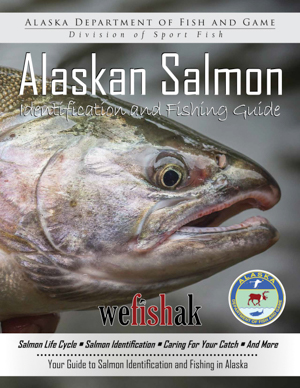 The Alaska Salmon Identification and Fishing Guide is a resource for anglers. This publication is available as a downloadable .PDF. Check it out and brush up on your knowledge of the five species of Pacific salmon native to the freshwaters of Alaska.
The Alaska Salmon Identification and Fishing Guide is a resource for anglers. This publication is available as a downloadable .PDF. Check it out and brush up on your knowledge of the five species of Pacific salmon native to the freshwaters of Alaska.
Good luck!
New “Five Salmon Family Challenge” Certificate – and Poster!
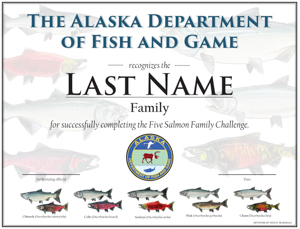

We encourage anglers to get out and fish together. The “Five Salmon Family Challenge” is a great opportunity to get out with a group of friends or family members and target all five species of Pacific salmon native to the freshwaters of Alaska. The challenge is open to all sport fish anglers.
We recently teamed up Shelly Marshall, who is a very talented Alaskan artist, to bring a new look to the Five Salmon Family Challenge certificate. Additionally, Shelly modified her popular “Alaska Salmon Species” poster to include the ADF&G logo. We are excited to have the opportunity to work with Shelly and make this poster available to anyone who completes the Five Salmon Family Challenge.
If you successfully complete the Five Salmon Family Challenge, you will receive a certificate with your name on it, and you will receive a poster designed by Shelly Marshall signed by the artist.
Learn more about the Five Salmon Family Challenge!
You can check out more art by Shelly Marshall and follow her on Instagram @shellartstudio.
Get out and fish. Together!
Change it up! Switching from a treble to a single hook.
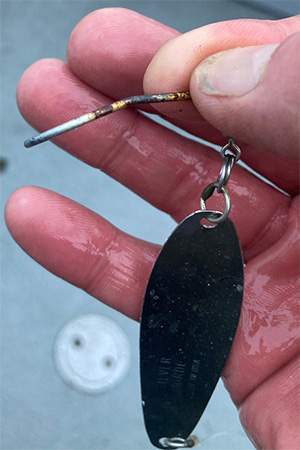 Last summer I had a conversation with a seasoned Kenai Peninsula king salmon angler who was frustrated with pre-season emergency order regulations that limited gear to single hook lures on the Anchor River. At first, I thought the angler was disappointed because he couldn’t use bait, but I quickly realized that he actually prefers to fish with treble hooks on his spinners. As an avid angler, he had no problems getting king salmon to bite, but without a treble hook he wasn’t able to land any. I had a lot of questions and eventually helped him figure out a few things to try the next time he went out. After we talked, I started thinking about how important it is to be able to swap hooks on lures - particularly going from treble to single point hooks in Alaska. Hooks eventually rust or bend long before the lure is ready to retire, and hooks are a lot cheaper to replace than lures. Also, many sport fisheries in Alaska require single hook lures even though many spoons and spinners sitting on sporting goods store shelves are dressed with treble hooks.
Last summer I had a conversation with a seasoned Kenai Peninsula king salmon angler who was frustrated with pre-season emergency order regulations that limited gear to single hook lures on the Anchor River. At first, I thought the angler was disappointed because he couldn’t use bait, but I quickly realized that he actually prefers to fish with treble hooks on his spinners. As an avid angler, he had no problems getting king salmon to bite, but without a treble hook he wasn’t able to land any. I had a lot of questions and eventually helped him figure out a few things to try the next time he went out. After we talked, I started thinking about how important it is to be able to swap hooks on lures - particularly going from treble to single point hooks in Alaska. Hooks eventually rust or bend long before the lure is ready to retire, and hooks are a lot cheaper to replace than lures. Also, many sport fisheries in Alaska require single hook lures even though many spoons and spinners sitting on sporting goods store shelves are dressed with treble hooks.
 Because of the benefits of using single hooks, I have progressed to the point where I prefer to use them most of the time, even when treble hooks are legally allowed gear. I have picked up a few tricks along the way that make them great. I don’t think there’s any doubt that a hook with three barbed points is better at initially hooking fish than a hook with only one barbed point, but it’s worth discussing if the fish stay hooked longer on trebles. The main advantage that I see with using single hooks is that you can use a larger and thicker hook that’s the same weight of a smaller treble hook. Maintaining a similar weight hook is important when replacing a hook so it doesn’t affect the action of the lure. A larger hook has a bigger gap, which allows the hook to be set deeper into the fish, which should give the angler a greater opportunity to land the fish. Heavier wire hooks won’t straighten out as fast as lighter ones, which can be important when fishing some of our bigger Alaska fish. Another benefit is that single hooks are better than trebles for releasing fish undamaged, which is important to be able to do even if you are not typically a catch-and-release angler. Fish long enough and you will end up letting fish go that you catch. Maybe you catch a species that you don’t want to keep, or you are required by regulation to release a fish hooked outside of the mouth. Lastly, treble hooks seem to get stuck in rocks, trees, and nets more which results in losing more lures and time lost fishing.
Because of the benefits of using single hooks, I have progressed to the point where I prefer to use them most of the time, even when treble hooks are legally allowed gear. I have picked up a few tricks along the way that make them great. I don’t think there’s any doubt that a hook with three barbed points is better at initially hooking fish than a hook with only one barbed point, but it’s worth discussing if the fish stay hooked longer on trebles. The main advantage that I see with using single hooks is that you can use a larger and thicker hook that’s the same weight of a smaller treble hook. Maintaining a similar weight hook is important when replacing a hook so it doesn’t affect the action of the lure. A larger hook has a bigger gap, which allows the hook to be set deeper into the fish, which should give the angler a greater opportunity to land the fish. Heavier wire hooks won’t straighten out as fast as lighter ones, which can be important when fishing some of our bigger Alaska fish. Another benefit is that single hooks are better than trebles for releasing fish undamaged, which is important to be able to do even if you are not typically a catch-and-release angler. Fish long enough and you will end up letting fish go that you catch. Maybe you catch a species that you don’t want to keep, or you are required by regulation to release a fish hooked outside of the mouth. Lastly, treble hooks seem to get stuck in rocks, trees, and nets more which results in losing more lures and time lost fishing.
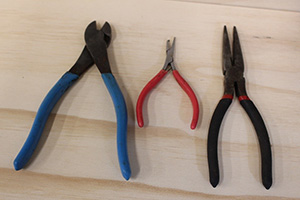 To replace the hooks on your lures, you’ll need just a few tools to do the job. First a good pair of heavy-duty cutters are needed to cut off the hook or welded ring. I prefer angled diagonal cutters, but any heavy-duty pliers with cutters will work. It’s best not to use your needle nose plier cutters or multi-tool cutter on thicker hooks, but it’s good to have a pair for holding hooks, rings, or lures. A pair of split ring pliers are also needed for replacing welded rings or attaching closed-eyed hooks to split rings.
To replace the hooks on your lures, you’ll need just a few tools to do the job. First a good pair of heavy-duty cutters are needed to cut off the hook or welded ring. I prefer angled diagonal cutters, but any heavy-duty pliers with cutters will work. It’s best not to use your needle nose plier cutters or multi-tool cutter on thicker hooks, but it’s good to have a pair for holding hooks, rings, or lures. A pair of split ring pliers are also needed for replacing welded rings or attaching closed-eyed hooks to split rings.
 The first step is to cut the hook or ring off the lure. If the spinner you are working on doesn’t have a welded or split ring between the hook and the lure, you have to cut the hook. If there’s a ring between, you have the option of cutting either the hook or the ring. Either are fine. If you are replacing a treble with a single hook and want to be able to keep the treble for later, then cut the ring. When working with spoons I tend to just cut the hook instead, so I don’t scratch up the paint when installing a new ring. If the welded ring is rusty, consider replacing it before it is a problem. For cutting off hooks, try snipping it near the top of the eye. Sometimes, it takes more than one cut and I prefer to hold the hook with my other hand or needle nose pliers so when the cut is made it doesn’t go flying off.
The first step is to cut the hook or ring off the lure. If the spinner you are working on doesn’t have a welded or split ring between the hook and the lure, you have to cut the hook. If there’s a ring between, you have the option of cutting either the hook or the ring. Either are fine. If you are replacing a treble with a single hook and want to be able to keep the treble for later, then cut the ring. When working with spoons I tend to just cut the hook instead, so I don’t scratch up the paint when installing a new ring. If the welded ring is rusty, consider replacing it before it is a problem. For cutting off hooks, try snipping it near the top of the eye. Sometimes, it takes more than one cut and I prefer to hold the hook with my other hand or needle nose pliers so when the cut is made it doesn’t go flying off.
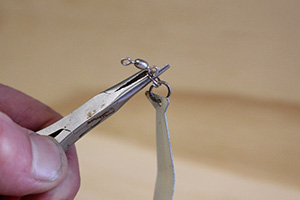 With the hook out of the way, it’s time to add in a split ring to the lure using a pair of split ring pliers. Size 2 or 4 are perfect split rings for small to medium size spinners and spoons. If you don’t have split ring pliers, you can use a small flathead screwdriver. Although it’s tempting and works just fine, I would avoid using the point of fishing hook to split the ring, so you don’t risk poking yourself. Once the ring is split, you can thread on the lure, closed eye hooks, and even a small swivel by working them all the way around the split ring until it closes. Using small swivels (size 7)
With the hook out of the way, it’s time to add in a split ring to the lure using a pair of split ring pliers. Size 2 or 4 are perfect split rings for small to medium size spinners and spoons. If you don’t have split ring pliers, you can use a small flathead screwdriver. Although it’s tempting and works just fine, I would avoid using the point of fishing hook to split the ring, so you don’t risk poking yourself. Once the ring is split, you can thread on the lure, closed eye hooks, and even a small swivel by working them all the way around the split ring until it closes. Using small swivels (size 7) 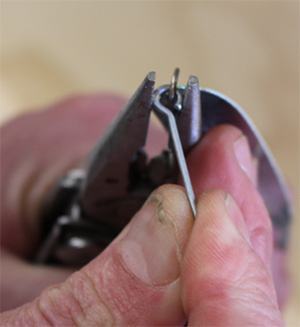 between your hook and split ring gives your hook some extra freedom of movement from the lure, which prevents the lure from behaving like a lever and prying the hook back out of the fish while fighting it.
between your hook and split ring gives your hook some extra freedom of movement from the lure, which prevents the lure from behaving like a lever and prying the hook back out of the fish while fighting it.
The last step is to attach the hook. Open-eye or siwash hooks are the easiest single hooks to replace, you squeeze the eye closed around the ring or swivel using pliers, but make sure the eye is actually closed all the way before using it. If you are using closed-eyed hooks they need to get threaded on through the split ring.
 Prepping this gear at home can really minimize frustration while on the water, increase the time you actually spend fishing instead of fixing gear, improve your chances of hooking fish, and landing them. Tight lines!
Prepping this gear at home can really minimize frustration while on the water, increase the time you actually spend fishing instead of fixing gear, improve your chances of hooking fish, and landing them. Tight lines!
Check out our Fishing Forums on YouTube
Have you ever wanted to learn how to fish for sheefish on the Yukon River? How about how to target sockeye salmon in freshwater? Be sure to check out our online fishing forums on YouTube to learn about a variety of topics related to fishing in Alaska. And be sure to subscribe to our channel as we will be posting more fishing forums in the future.
Field to Plate – Recipe of the month
Recipe of the month: North African-Style Alaska Salmon
 Try this delicious recipe for North African-Style Alaska Salmon from our friends at the Alaska Seafood Marketing Institute.
Try this delicious recipe for North African-Style Alaska Salmon from our friends at the Alaska Seafood Marketing Institute.
Enjoy!
If you have any questions about the Reel Times newsletter, please contact Ryan Ragan at ryan.ragan@alaska.gov

